I was in three short workshops this past weekend at a big art ‘Palooza’ and trade show in Raleigh. The downtown Hilton had taped plastic over all their 1st floor meeting room carpets (!) and all the conference tables were covered with plastic, converting many spaces into studio workrooms. Some of these rooms had 30 or more learners staking out places at tables and unpacking their tools with anticipation.
You should have seen the crowd in this fine hotel: scraggly characters walking around in their paint spattered clothes.
The costs, especially for the supply store, were LOW compared to any discount house, so the gatherings were jammed. About 34 teaching artists, from all over the country, held court in each of these many rooms. Speed dating meets art class I suppose.
Each teacher had to discipline his presentation, highlight tools, gather the crowd for demos, and then let the students do practice sets. I learned some tricks. I bought a lot: new colors, supports to work on etc. But mostly I’m taking this home: practice what you already know and have. Dig in and keep at it. Keep your body moving toward what your heart is after. And don’t take partial as the finish.
What I mean is there were dabblers here at this conference, but also lots of examples from persevere-ers too. You can see the difference. The ones making progress are holding on alertly, curious, and active.
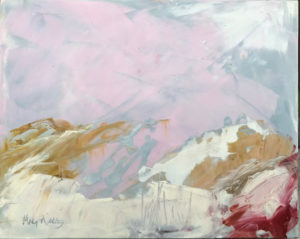 In one class there were so many folks that the teacher really couldn’t take much time beyond the basics, so I stayed in the back, one ear listening while I just worked and worked, turning out 5 pieces in 3 hours. The results were good. Here is one of them. What was the difference then for me compared to staying home and working? I am still thinking about that.
In one class there were so many folks that the teacher really couldn’t take much time beyond the basics, so I stayed in the back, one ear listening while I just worked and worked, turning out 5 pieces in 3 hours. The results were good. Here is one of them. What was the difference then for me compared to staying home and working? I am still thinking about that.
But here’s maybe an illustration that cuts to the chase. Eugene Peterson tells the story: the theologian Karl Barth was on a bus in his Swiss town, when a tourist came and sat next to him. Barth struck up a conversation. “You are a visitor, yes? And what do you want to see in our city?” The man said, “I would like to see the great theologian Karl Barth. Do you know him?” “Oh yes, I shave him every morning.” The man went away satisfied, telling his friends that he had met Barth’s barber.
There is joy here in this illustration for me, for I have sitting next to me, whether here or on the road, the One I really want to see and learn from. I just have to keep asking as I work.
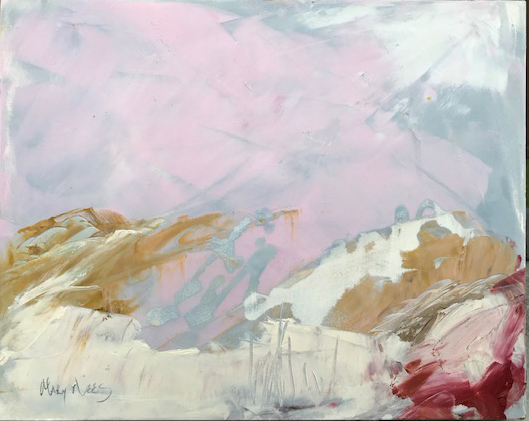
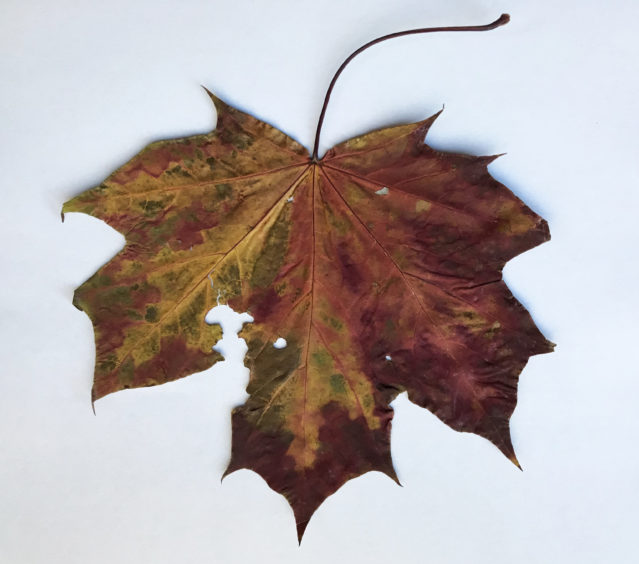
 Last night, near the point of retiring for the day, I opened a small poetry book, a gift given to me in Canada. Therein I found an added bit of beauty between the leaves. Pressed in the pages of this lovely booklet was a singular remnant from a maple. I had almost squished this leaf with my shoe on a walk in Vancouver. My eyes must have stopped me then, but I forgot that I had this incredible thing. The re-discovery near a month later was more delight than I even remembered in the initial find.
Last night, near the point of retiring for the day, I opened a small poetry book, a gift given to me in Canada. Therein I found an added bit of beauty between the leaves. Pressed in the pages of this lovely booklet was a singular remnant from a maple. I had almost squished this leaf with my shoe on a walk in Vancouver. My eyes must have stopped me then, but I forgot that I had this incredible thing. The re-discovery near a month later was more delight than I even remembered in the initial find.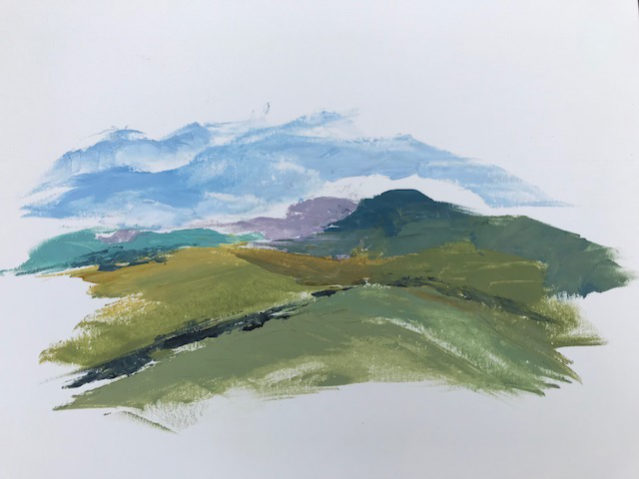
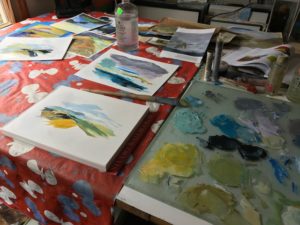 Yesterday in studio I worked up a palette of hues in oil, building from a photo I’d saved of an arctic scene in National Geo. You can see that here if you look closely at my messy table. I mixed up a set of replicated hues, pleasing together, and then added notes of my own with them, before I had any idea what I would do myself with this color grouping.
Yesterday in studio I worked up a palette of hues in oil, building from a photo I’d saved of an arctic scene in National Geo. You can see that here if you look closely at my messy table. I mixed up a set of replicated hues, pleasing together, and then added notes of my own with them, before I had any idea what I would do myself with this color grouping.
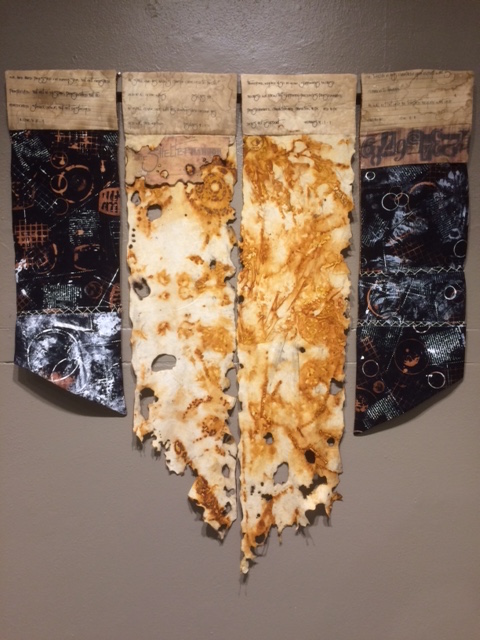
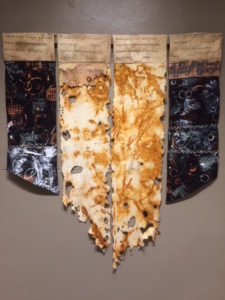


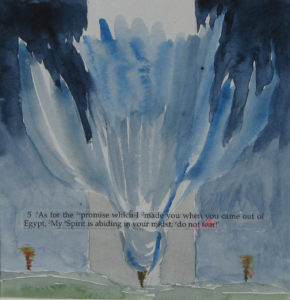
 “First I have the picture” Einstein reportedly said, “then I come up with the math”. Before any of us knew how to decode language, our little eyes trained on images. Even the cones on our retinae respond to color before form is understood. We begin from image impression, but then sometimes the more we “know” what’s in front of us, the less we can wholly grasp.
“First I have the picture” Einstein reportedly said, “then I come up with the math”. Before any of us knew how to decode language, our little eyes trained on images. Even the cones on our retinae respond to color before form is understood. We begin from image impression, but then sometimes the more we “know” what’s in front of us, the less we can wholly grasp.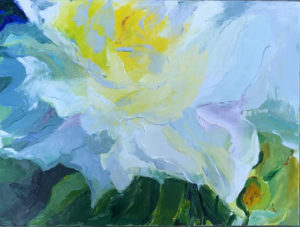 darks and lights from a photo of a magnolia blossom. What was important in translating this into paint was not “this is a magnolia’ but rather more than that, and I needed to take time to consider how. My oil color is carefully selected. But what excites me is the emergent shine, and the impasto lending toward a sense of exuberance. The cropping too was a choice, as if I am just teasing the viewer into only a glimpse. Glimpses for me are key, for if I try to tell the whole story, we’ll all get lost in words. There’s an energy in this translation into color that springs off the canvas. Usually I dive into work from an idea in my head, but to take the time to map it first, if even so simply, is important, and more than I knew. I’ve heard about the necessity of sketchbook planning, but since I’m not much of a draftsman and am also impatient, I’ve often skipped that part. “I see said the blind man”. So this mapping process was a win for me, and it’s informing further practice.
darks and lights from a photo of a magnolia blossom. What was important in translating this into paint was not “this is a magnolia’ but rather more than that, and I needed to take time to consider how. My oil color is carefully selected. But what excites me is the emergent shine, and the impasto lending toward a sense of exuberance. The cropping too was a choice, as if I am just teasing the viewer into only a glimpse. Glimpses for me are key, for if I try to tell the whole story, we’ll all get lost in words. There’s an energy in this translation into color that springs off the canvas. Usually I dive into work from an idea in my head, but to take the time to map it first, if even so simply, is important, and more than I knew. I’ve heard about the necessity of sketchbook planning, but since I’m not much of a draftsman and am also impatient, I’ve often skipped that part. “I see said the blind man”. So this mapping process was a win for me, and it’s informing further practice. We’re preparing. And since visuals speak so powerfully to me, I painted a symbol on our front door. Similar to any other sign, one has to stop here and think. Strange things require some investigation to understand what’s really going on. People who know me already are primed for surprises. My engineer looked tentatively, bemused at the gleam in my eyes as to what I’d done now. One of my daughters just smiled at her weird mom. I got out some red paint, and researched which branches in my backyard would more closely resemble the hyssop used in Exodus. When the Israelites were told to paint blood on the lintel and posts of their doors right before their great rescue it must have been a truly weird act of faith. But the
We’re preparing. And since visuals speak so powerfully to me, I painted a symbol on our front door. Similar to any other sign, one has to stop here and think. Strange things require some investigation to understand what’s really going on. People who know me already are primed for surprises. My engineer looked tentatively, bemused at the gleam in my eyes as to what I’d done now. One of my daughters just smiled at her weird mom. I got out some red paint, and researched which branches in my backyard would more closely resemble the hyssop used in Exodus. When the Israelites were told to paint blood on the lintel and posts of their doors right before their great rescue it must have been a truly weird act of faith. But the 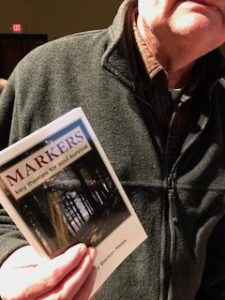
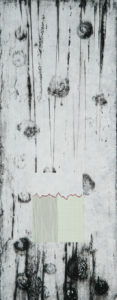 I showed them some pieces like this one, “Time and Mercy” where the chaos is falling down all around the inner life. But there on the inside is the mark of a heartbeat, and the recording of time. There’s a history that is undeniable, part of the fabric that cannot be changed. There’s a span ahead yet unknown. But in this present moment I can breathe and pause. This is the potential moment where beauty is born. For right now I can lift my head because the evidence of love is still shining through for those who are eager for it.
I showed them some pieces like this one, “Time and Mercy” where the chaos is falling down all around the inner life. But there on the inside is the mark of a heartbeat, and the recording of time. There’s a history that is undeniable, part of the fabric that cannot be changed. There’s a span ahead yet unknown. But in this present moment I can breathe and pause. This is the potential moment where beauty is born. For right now I can lift my head because the evidence of love is still shining through for those who are eager for it.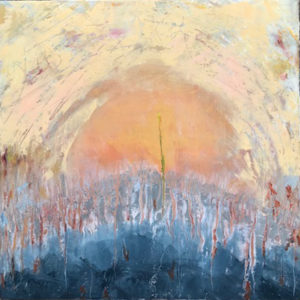 The theme keeps repeating and it’s a universal one. From mythology to classic literature this idea of trekking toward some kind of attainment is in our DNA. Moses, Odysseus, Buddha, Lao Tzu, Dante — the list is long of courageous ones who were answering the ancient quest “where have you come from, and where are you going?”* Something keeps us moving, sometimes for what we’re not even sure; and if our bodies get tired, our spirits keep longing.
The theme keeps repeating and it’s a universal one. From mythology to classic literature this idea of trekking toward some kind of attainment is in our DNA. Moses, Odysseus, Buddha, Lao Tzu, Dante — the list is long of courageous ones who were answering the ancient quest “where have you come from, and where are you going?”* Something keeps us moving, sometimes for what we’re not even sure; and if our bodies get tired, our spirits keep longing.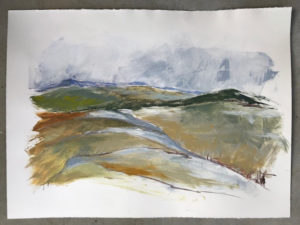 cam. It’s lived so slow from our angle. We move here on the ground at a snail’s response to what is happening second by second in the heavenlies. My sky here is active, for that’s where the real drama is being directed. The land only reflects the weather patterns and the light working above it. I live on the ground, held by gravity, where time creeps sometimes agonizingly slow. I don’t like that slowness, for there’s so much that needs to change down here, so much I long for from the only One who can bring us justice and peace. Humans and their leaders so disappoint me! He said He’d return, why is He taking so long!?
cam. It’s lived so slow from our angle. We move here on the ground at a snail’s response to what is happening second by second in the heavenlies. My sky here is active, for that’s where the real drama is being directed. The land only reflects the weather patterns and the light working above it. I live on the ground, held by gravity, where time creeps sometimes agonizingly slow. I don’t like that slowness, for there’s so much that needs to change down here, so much I long for from the only One who can bring us justice and peace. Humans and their leaders so disappoint me! He said He’d return, why is He taking so long!?
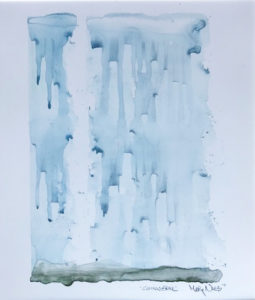 The advantage I have doing art is that I can “tell it slant” as Emily Dickinson used to say. There is no muzzle on when the work sings with beauty on its own. Makoto Fujimura explains it: “Art is an inherently hopeful act, an act that echoes the creativity of the Creator. Every time an architect imagines a new building, an artist envisions that first stroke of a brush on a white canvas, a poet seeks a resonant sound in words, or a choreographer weaves a pause in layers of movements, that act is done in hope; the creator reaches out in hope to call the world into that creation.” –Refractions (NavPress, 2009), 68.
The advantage I have doing art is that I can “tell it slant” as Emily Dickinson used to say. There is no muzzle on when the work sings with beauty on its own. Makoto Fujimura explains it: “Art is an inherently hopeful act, an act that echoes the creativity of the Creator. Every time an architect imagines a new building, an artist envisions that first stroke of a brush on a white canvas, a poet seeks a resonant sound in words, or a choreographer weaves a pause in layers of movements, that act is done in hope; the creator reaches out in hope to call the world into that creation.” –Refractions (NavPress, 2009), 68.